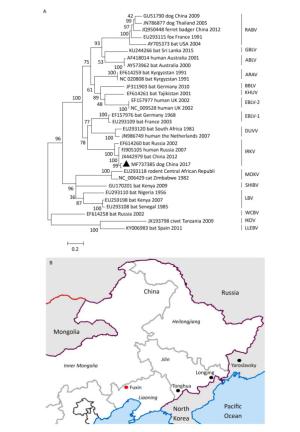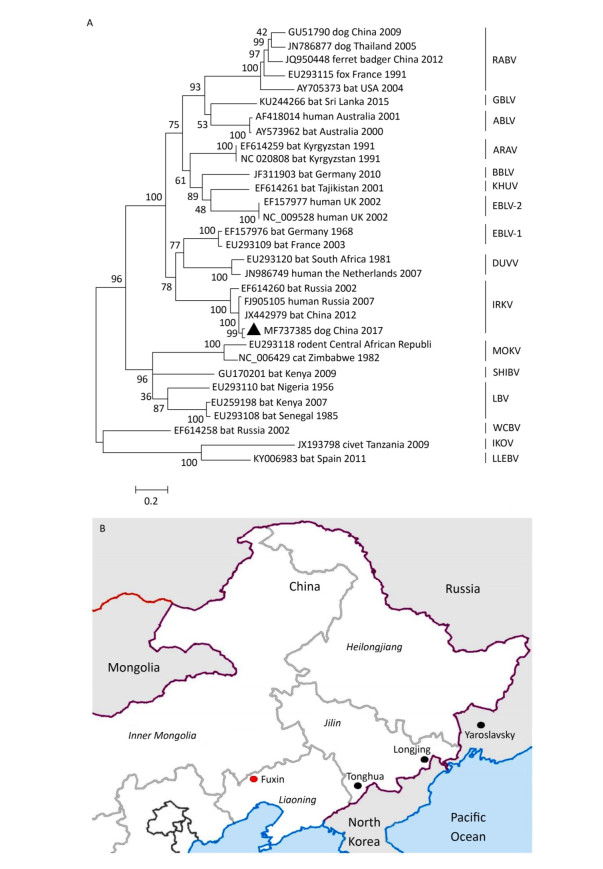-
Genus Lyssavirus currently comprises 14 species and 2 unclassified species that are all associated with bats, except for Ikoma lyssavirus and Mokola virus[1]. Among them, rabies virus, Duvenhage virus, European bat lyssavirus 1, European bat lyssavirus 2, Australian bat lyssavirus, and Irkut virus (IRKV) have caused human fatalities[2].
IRKVs belong to the Irkut lyssavirus species and were first isolated from Murina leucogaster bats in 2002 and 2012 in East Siberia (Russia) and Jilin province (China, Figure 1A), respectively. Only one confirmed spillover infection was reported in 2007, which led to a human fatality caused by a bat bite in the Russian Far East (Figure 1B)[3]. In China, two human rabies cases after bat exposures have been reported in Jilin province[4]. IRKV is the only bat lyssavirus isolated in China to date. Nevetheless, infection of IRKV in dogs has not been previously reported.

Figure 1. (A) Maximum likelihood of the lyssavirus-rooted phylogenetic tree based on the complete N sequences. Irkut virus FX17 is marked using black triangle on the tree. Bootstrap values are presented as percentages for key nodes, and branch lengths are indicated using a scale bar. EBLV-1: European bat lyssavirus-1; DUVV: Duvenhage virus; IRKV: Irkut virus; ARAV: Aravan virus; BBLV: Bokeloh bat lyssavirus; KHUV: Khujand virus; EBLV-2: European bat lyssavirus-2; ABLV: Australian bat lyssavirus; RABV: rabies virus; WCBV: West Caucasian bat virus; SHIBV: Shimoni bat virus; MOKV: Mokola virus; LBV: Lagos bat virus; IKOV: Ikoma lyssavirus; GBLV: Gannoruwa bat lyssavirus; and LLEBV: Lleida bat lyssavirus. (B) Fuxin city and surrounding regions in Russia and China. Black dots indicate the location of IRKV-associated human rabies cases within China and Russia. The red dot identifies where Irkut virus FX17 was detected.
On July 1, 2017, in Zhangwu County, Fuxin City, Liaoning province, China (Figure 1B), a local farmer was bitten on his right heel by a free-roaming dog owned by his neighbor. He neglected the rabies vaccination at that time and later received the 2-1-1 program of post-exposure prophylaxis (PEP) on July 5. On July 10, the dog died of an unknown cause. On July 18, the farmer sent his serum sample and the seriously rotten dog brain to our laboratory for rabies antibody test and diagnosis. Rabies virus neutralizing antibody (RVNA) was assayed using standard fluorescent antibody virus neutralization (FAVN) method and the value of RVNA titer (23.38 IU/mL) was higher than the minimum antibody level (0.5 IU/mL) after vaccination[5]. Virus cannot be isolated from the seriously rotten sample by using the rabies tissue culture inoculation test and the mouse inoculation test. The dog brain sample was tested using reverse transcription polymerase chain reaction (RT-PCR), in which the complete N gene was amplified and sequenced as previously described[5]. The sequence was found to be highly similar (99%) with the isolate IRKV-THChina12 (GenBank no. JX442979) from a Murina leucogaster bat in 2012 from Jilin province (Figure 1A). The new N gene sequence from the dog brain was submitted to GenBank, with accession number MF737385.
To analyze the pathogenicity of IRKV in dogs and cats, 5 one-year old dogs and 6-month old cats were injected at the hind limb skeletal muscle with the same dose of IRKV-THChina12 (50, 000 mouse LD50/ dose). All animal experiments described in this paper have been conducted according to the Guidelines for the Humane Treatment of Laboratory Animals stipulated by the Ministry of Science and Technology of the People's Republic of China and approved (License China. One dog and three cats presented with rabies symptoms, such as lethargy, muscle weakness and progressive paralysis of one or both hind limbs, and died 8-14 days post-infection (Table 1). Brain tissues and saliva samples were collected from the dead animals and tested again for IRKV antigen and RNA by the direct immunofluorescence assay (DFA) and RT-PCR[4]. All samples from the dead animals are IRKV-positive and the other animals survived without any symptom after 90 days post-infection. All living animals were euthanized with an overdose of pentobarbital sodium at the end of the study and tested for IRKV antigen and RNA by the DFA and RT-PCR[4]. All brain and saliva samples from the survived animals are IRKV-negative.
Animals Incubation Period (days) Morbidity Period (days) Dog 2017-1 7 1 Dog 2017-2 / / Dog 2017-3 / / Dog 2017-4 / / Dog 2017-5 / / Cat 2017-1 / / Cat 2017-2 7 1 Cat 2017-3 9 1 Cat 2017-4 / / Cat 2017-5 13 1 Note.'/': survivor animals. Table 1. Pathogenicity of IRKV-THChina12 in Animals after Intramuscular Injection
The close relationship between humans and pets, such as dogs and cats, might generate a new spillover-spreading route for IRKV infection. Although the origin of IRKV infection in the dog was unclear, many lyssaviruses including IRKV are maintained primarily if not exclusively in bat hosts while dogs are a well-established reservoir for rabies virus. Therefore, rabies vaccination of dogs and cats is necessary to control and prevent infection of rabies viruses and non-rabies lyssaviruses. In China, active non-rabies lyssavirus survey is not systematically performed because real-time surveillance of animal cases is still officially lacking[4]. Additional attention should be paid to trans-species infection of IRKV between bats and dogs or dogs and humans. In addition, commercial rabies biologics do not provide 100% protection against IRKV infection as reliable as that against rabies infection[6, 7]. Before the development of new biologics, such as chimeric vaccines and MAbs, the proper assessment of their public health and veterinary implications is necessary through investigation of the prevalence and circulation patterns of IRKV in China.
Author Contributions Conceived and designed the experiments: HU Rong Liang and LIU Ye. Performed the experiments: CHEN Teng, MIAO Fa Ming, and ZHANG Shou Feng, ZHANG Fei, and LI Nan. Contributed reagents/materials/analysis tools: CHEN Teng, MIAO Fa Ming, and LIU Ye.
Possible Transmission of Irkut Virus from Dogs to Humans
doi: 10.3967/bes2018.017
the National Key Research and Development Program of China 2016YFD0501000
the National Key Research and Development Program of China 2017YFD0500600
the National Key Research and Development Program of China 2017YFD0502300
the National Key Research and Development Program of China 2016YFD0500401
- Received Date: 2017-10-10
- Accepted Date: 2018-01-08
Abstract: Lyssaviruses, including Rabies virus, Duvenhage virus, European bat lyssavirus 1, European bat lyssavirus 2, Australian bat lyssavirus, and Irkut virus (IRKV), have caused human fatalities, but infection of IRKV in dogs has not been previously reported. In China, a dead dog that previously bit a human was determined to be infected with IRKV. Pathogenicity tests revealed that IRKVs can cause rabies-like disease in dogs and cats after laboratory infection. The close relationship between humans and pets, such as dogs and cats, may generate a new spillover-spreading route for IRKV infection. Therefore, additional attention should be paid to trans-species infection of IRKV between bats and dogs or dogs and humans through investigation of the prevalence and circulation patterns of IRKV in China.
| Citation: | CHEN Teng, MIAO Fa Ming, LIU Ye, ZHANG Shou Feng, ZHANG Fei, LI Nan, HU Rong Liang. Possible Transmission of Irkut Virus from Dogs to Humans[J]. Biomedical and Environmental Sciences, 2018, 31(2): 146-148. doi: 10.3967/bes2018.017 |








 Quick Links
Quick Links
 DownLoad:
DownLoad: